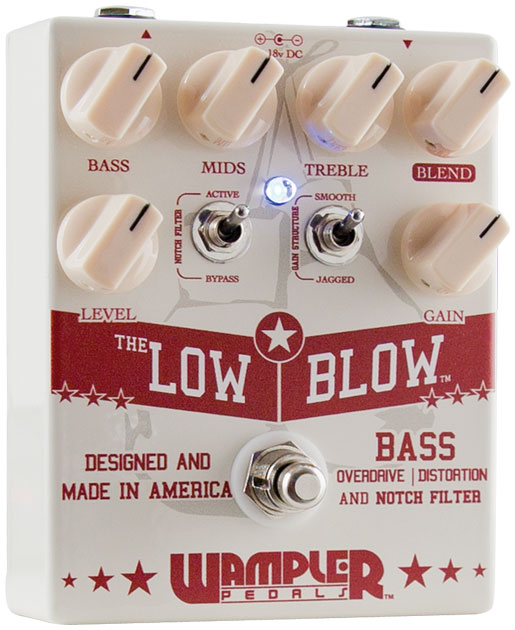Brian Wampler has made a career of chasing tones and frequencies in an effort to create the ultimate collection of pedals. After designing a number of revered overdrives and distortions for guitarists over the years, the pedal designer started getting bombarded with inquiries from low enders for a pedal that answered their gritty needs. Answering their call, Wampler has introduced the company’s first pedal for bassists with the Low Blow.
 Tone for All
Once Wampler was underway working on creating and tweaking a bass circuit, he distributed his new project to a large group of players for testing and critique so he could improve and refine before unveiling. Rather than going the simple route of only level, blend, and gain controls, Wampler’s stylish cream-colored Low Blow houses plenty more to help sculpt bass-distortion rowdiness. In addition to the expected cast of characters, the Low Blow boasts a 3-band EQ, a notch filter, and a gain-structure switch.
Tone for All
Once Wampler was underway working on creating and tweaking a bass circuit, he distributed his new project to a large group of players for testing and critique so he could improve and refine before unveiling. Rather than going the simple route of only level, blend, and gain controls, Wampler’s stylish cream-colored Low Blow houses plenty more to help sculpt bass-distortion rowdiness. In addition to the expected cast of characters, the Low Blow boasts a 3-band EQ, a notch filter, and a gain-structure switch.
Even with a passive bass through a 1x12 combo, the pedal showed tremendous grit and punch. It’s the two switches that really define the diversity of the pedal. The notch filter changes the tone of the pedal by redefining the EQ to cut out any woofiness that can build up in a signal chain. The gain-structure section offers smooth and jagged settings, with the smooth providing an amp-overdrive-like tone and the jagged offering a more aggressive, distorted sound.
Jagged Little Pill Getting down to business with a Fender P and an SWR LA12, I started out with the blend, level, and gain dials set to 12 o’clock, the gain structure set to smooth, and the notch filter activated. I immediately realized that smooth was merely a suggestion for the sound that occurred. Even with a passive bass through a 1x12 combo, the pedal showed tremendous grit and punch.
It was only when I switched the gain structure to jagged that I was able to understand where the smooth moniker came from. The tone became notably more distorted with a whole new layer of crunch and much less compression to limit the frequency. In both settings, the sustain prevailed huge in providing long, full notes at any register on the bass.
Ratings
Pros: The notch filter and 3-band EQ. Delivers a wide range of overdrive and distortion frequencies. Gain-structure control offers two distinct overdrive options.
Cons: Six knobs and two switches might be a bit busy for those looking for simplicity.
Tones:
Ease of Use:
Build/Design:
Value:
Street: $209.97
Wampler Pedals Low Blow wamplerpedals.com
Keeping the same settings in smooth mode with the notch filter bypassed, the pedal produced more of a vintage-sounding overdrive that proved to be an ideal crunch for both fingerstyle and pick playing. The lows kept their growl and weren’t overly booming given the compression of the pedal, but the midrange really took center stage in bypass mode. The attack is extremely pronounced and is especially present when playing with a pick. When I pushed the blend and gain to 3 o’clock, and rounded the bass and mids to 1 o’clock, the low end took on a huge, round body that pushed the amp while keeping a pure tone with no loss of note singularity.
Bands of Gold The 3-band EQ proved to be a hot commodity in sculpting the tone. When increasing and decreasing the gain and blend, it was obvious that the pedal shines most in the midrange side of things, but adjusting the bass, mids, and treble dials can balance that out. When I took the treble down to 9 o’clock, set the mids at 1 o’clock, and rolled the bass on thick at 4 o’clock, the amount of low end from the independent boost became a powerful force with just enough compression to keep it from becoming unruly.
I discovered my favorite setting by activating the notch filter, setting the gain structure to smooth, setting the volume, blend, and gain at 3 o’clock, rolling the bass and mids to 1 o’clock, and leaving the treble at noon. This conjured up a high-gain tone with a menacing sound, but didn’t present the muddy undertones that can plague other overdrive/distortion pedals. The high end screamed while the low end and mids remained rumbling and dominant, creating a sound that would satisfy even the toughest bass shredder.
The Verdict In creating their first overdrive/distortion strictly for bassists, Wampler has hit the mark with a pedal that might make your guitarist envious. The Low Blow doesn’t rewrite the book on bass overdrives and distortions, but it certainly provides more customizable options than most of its contemporaries. The notch filter is excellent for enhancing the EQ curve and giving more bite, while the gain structure offers up two modes of totally different sonic grit with its smooth and jagged settings. If you’re looking to add some meat to your tone and have a whole lotta tone-sculpting tools to find the sweet spot you’re after, the Low Blow might be your huckleberry.
